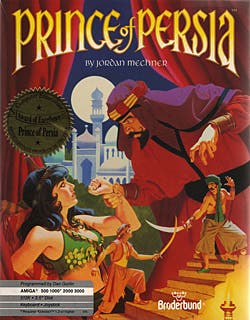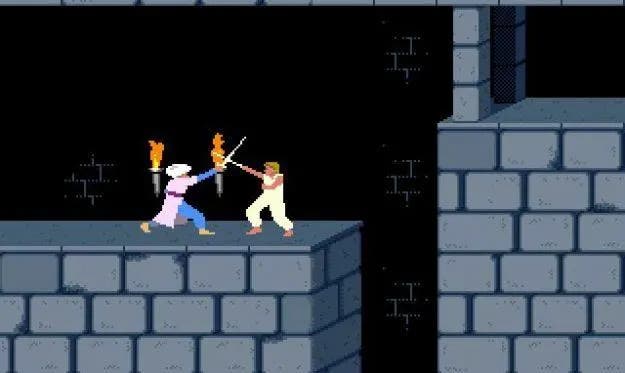The original Prince of Persia is a reminder that this series has always been lost inside time
Crowning jewels.
For years, I was aware of Prince of Persia without playing it. I loved platform games, but Prince of Persia didn't feel like it was just a platform game. I detected something else in it, something too smart for me, too challenging, too close - and slightly creepy - in its approximation of real human movement. I played a lot of platformers on the Master System, where I was often taking funny cartoon animals for a walk and a jump: Psycho Fox, Mickey (and his Castle of Illusion), and the feathers-and-scales quick-changes of Wonder Boy 3. Prince of Persia ran on more grown-up machines, like the Amiga, and if I had to put a clumsy phrase to whatever that kept me away from it, it was that: the game felt too grown up for me.
Now I am ostensibly grown up, I've spent the last week trying to understand why I ever felt this way. It certainly wasn't because of the plot - save the princess - or due to any nuanced understanding of actual Persia. With its blonde hero and evil viziers, Jordan Mechner's game was clearly based on the old Hollywood take on its subject matter. (More on this later.) But when I looked at screenshots this week and played Prince in a browser in a way that would have blown the mind of the person I was in 1989 when the game was first released in North America, I felt that same sensation. I remembered the slightly chilly confusion I had felt when I first saw the game running at friends' houses, often on machines that belonged to older siblings. It was the sense that I was looking at something very new and - somehow - also very old.
The difference - and it's over thirty years' difference - is that I now love this feeling. It's nostalgia, but with something stranger mixed in there too. And in playing the game a bit - and having just played through the latest installment in the series, the glorious Prince of Persia: The Lost Crown - I think I may be starting to understand my reaction a little bit better.
In many ways, Prince of Persis takes its cues from Karateka, an earlier game from Mechner. Karateka is where a lot of people see the roots of stuff like Uncharted: it's a game, but it apes cinema, in this case martial arts cinema. It has a plot, and it has sprites who move through elegant, recognisably human rotoscoped animations. But it also has editing - the story cuts back and forth from the goodies and the baddies. It's princess rescuing, like Mario, but it's drawing from Kurosawa, block prints, and manga (I gather this is where we get the blonde haired hero again).
Given this context, Prince is the same, but more and more elaborate. It's complex environments with different levels and backtracking instead of the left-to-right progression of Karateka. It's sword fights instead of martial arts. It's traps and potions and set-pieces, one involving a helpful mouse. That mouse aside, it's everything you expect in a designer's follow-up to an influential classic.
But Prince, as they say, hits different to me. And a lot of this is down to the rotoscoped animation, which is suddenly a lot more elaborate, and, it feels, even more vividly human than the stuff seen in Karateka. The Prince is young and perhaps inexperienced, and we can now see that through his animation. He pelts along but always seems in danger of misunderstanding his own momentum. He steps back tentatively after almost falling, he really has to put in the effort when he's mantling. His jumps and trips have a human desperation to them. And even though I'm controlling him through each sword fight, I fear for him with every lunge and parry.
A lot of what I felt as Prince's fancy chilliness is actually located here, I think. The Prince's movements flow together elegantly, but for me, rotoscoped animation always makes me feel more distanced from the character rather than closer to inhabiting them. This isn't a criticism: I find it kind of fascinating. It feels like there's a synaptic pause or hiccupy disconnect between me jabbing a button on the computer - very much an on/off affair - and the Prince's smooth motions and billowing clothes.

(I get this same feeling in the early Tomb Raiders, which I absolutely adore, and which I can now see are deeply influenced by the Prince. With Tomb Raider, when I'm playing the Core games, I always feel like I'm playing the control system, the grid system. I'm Lara, kind of, but also I'm not Lyra. I'm able to peer beyond her jumps and flips and handstands and see the binary chug of that control scheme that I am slowly learning to master. That's the distinct fun of it all.)
But there's something else in the rotoscoping too, and I think it's why I've fallen in love with the Prince so hard this last week. That sense of something being new but also old. I'd never seen animation like this in a video game, but I had seen something like it somewhere.
With its bold, expressive gestures, its side-on view of the action and its emphasis on clarity and selling the physical reality of each moment, it's hard not to look at Prince of Persia in motion and think of silent movies and the early days of cinema. It's not just that blonde heroes and evil viziers were safe staples back then, it's that slapstick and melodrama ruled, as did "bits of business" formed of an understanding of cause and effect, momentum and collision that was clear to both the creators and the audience enjoying it all.

I don't think anybody would think see this as a knock either. The silent movies were a time of incredible compressed imagination and invention. Rules were not yet codified, bold experiments were common, performers were risking their lives for a shot, cameras were experiencing a burst of wild mobility. Trains powered straight for the screen, while in turn the audience could float over tables where flying aces were drinking cocktails. This was cinema in those brilliant, unstable early moments when people had yet decided what cinema could be, and I think you see a bit of that stark freshness in Prince.
More than that, though, as I'm now looking at a game that's well into its fourth decade, I look at the rotoscoped animations and think: wow, I'm seeing the past reanimated here, the real past. You know, like the family members who provided the movements that Mechner filmed and turned into sprites, and - just learned this - the ghosts of Errol Flynn and Basil Rathbone, whose celluloid sword fighting was translated into the Prince's own lunges and parries. Here's Flynn, reanimated long after his death, here's his physical brilliance, his body's unique charisma, trapped and looping still.
I love this. All games become historical documents after a few years, of course, but there's something so complex going on in Prince of Persia, in the way it still has the impact of a technical marvel but also of something that reaches back to the 1920s and 1930s and a different kind of virtuosity. And it makes sense. Since its modern 3D incarnations, the series has been known for tying chronology in knots and spinning the arrow of time on its signpost. And it turns out that the original game, back at the start of it all, was already deeply into that kind of jazz.










